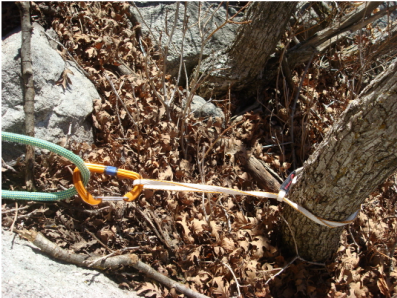The Girth Hitch
 A girth hitch around a tree, using a 48 inch runner.
Applications: building anchors, connecting two loops, attaching to a natural anchor
The Girth Hitch is a common way of attaching a natural anchor, because it is quick, easy to tie, and doesn't cause excess stress on the webbing or rope. It requires a loop, so it is most often tied using a runner or cordelette. It can also be used to connect two loops together, although Black Diamond did a strength test of different hitches, and found that girth hitches reduced the strength of the slings in all materials. How to tie: Find the thinnest and most stable part of the object you wish to hitch to (i.e., the waist of a rock knob, or the trunk of a tree directly above the roots), and pass the webbing or rope around the back. Using the thinnest part of the object will insure that the hitch will not jump or settle when loaded. Also be sure to only hitch to stable trees, rocks, etc. as the hitch's strength will rely on it. Pass one end of the loop through the other end, and cinch tight. On trees, line up the outer loop with the center of the tree, since it can be difficult to get the webbing to slide around the tree, and can be potentially harmful to the webbing. |
|
